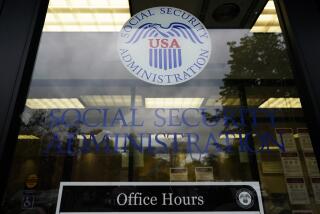Living on borrowed time
- Share via
THE IDEA that everyone should be a property owner has much to commend it. There is a long and distinguished tradition in the English-speaking world of seeing individual liberty and property ownership as intertwined. In Britain and the United States, property ownership was the original basis for the right to vote.
In the 19th century, democratization meant giving the vote to people who were property-less. It was not until the 20th century that people began to dream of a society in which every voter would also be an owner-occupier. In the U.S., beginning with the Federal Housing Administration in the 1930s, there has been a sustained effort to encourage people to become property owners, with incentives ranging from government-guaranteed mortgages to tax deductions for mortgage interest payments.
It worked. Before the 1930s, no more than two-fifths of American households were owner-occupiers. Today, the proportion is 68%.
Yet you can have too much of a good thing. Maybe not everyone is cut out to be a property owner. Maybe we should not be bribing and cajoling people at the financial margins into taking out mortgages. And maybe a day of reckoning is approaching, when the costs of this policy will have to be borne not just by a minority of overburdened households but by everyone.
The last decade or so has seen a stampede by banks and other financial institutions to lend money to poor Americans. But these were not mortgages like the ones given to middle-class Americans in the 1930s and 1940s, which were generally for 20- or 30-year terms with low fixed-interest rates. These “sub-prime” mortgages were generally for just a few years, with adjustable or floating interest rates. At the point of sale, the monthly payments were alluringly low and often made more so by so-called teasers. But these teasers were programmed to expire after two years, at which point the borrower was exposed to the full market rate, plus a premium. Since 30-year fixed mortgage rates have risen by roughly a quarter since June 2003 (from 5.34% to 6.66%), the result has been a shockwave running through “sub-prime” America.
Suddenly, housing is no longer a one-way bet. Across the country, according to the S&P;/Case-Shiller index, house prices are falling year on year for the first time since 1991. In Detroit, which has been among the cities worst hit, they are down 11%. In Memphis, Tenn., the local newspaper carries 20 small-print pages of foreclosure announcements. You can watch the homes in question being auctioned off, 30 at a time, on the courthouse steps.
To which you may be tempted to retort: caveat emptor. If people take out loans they can’t afford to service, they only have themselves to blame. There are two reasons, however, why this is not the right response. The first is the abundant evidence of cynical predatory lending targeted at “sub-prime” neighborhoods. Some of these mortgages were deliberately designed to be unaffordable after Year 2; they were always going to end in foreclosure. Typical were the so-called NINJA loans, which you could get with “no income, no job or assets.” The second point is that it is not easy for buyers to be wary when they are, by and large, poorly educated in basic finance.
In any case, the problems in the sub-prime mortgage market are not confined to the borrowers. The explosion of defaults and foreclosures also threatens to set off a chain reaction extending right through the global financial system. But it’s not just that big banks have allowed their subsidiaries to make bad loans, though you can see some big names (among them Deutsche Bank) in the Memphis foreclosure notices. Much more serious is the way that sub-prime mortgage defaults can now have an impact on seemingly unconnected financial markets.
The key is the way that sub-prime mortgage-backed bonds have been used as the collateral for fancy instruments called collateralized debt obligations, or CDOs, which are divided into slices, or “tranches,” based on different credit qualities. This is financial alchemy: using sub-prime mortgages to produce a top tranche of triple-A-rated securities is the equivalent of turning lead into gold. But is it fool’s gold?
Last month, two hedge funds owned by the New York investment bank Bear Stearns were all but wiped out by their CDO holdings. Others are also reporting heavy losses. Now the ratings agencies are downgrading scores of mortgage-backed securities. You could see the pain spreading contagiously last week into the credit and currency markets. Down went the dollar.
None of this is to regret the passing of housing projects, where the poor paid subsidized rents for accommodation they had no incentive to maintain, much less improve. But it is to question the wisdom of trying to convert everyone into a homeowner by market forces alone.
In the absence of universal economic literacy, the property-owning democracy runs the risk of becoming not just uncreditworthy, but discredited.
More to Read
Inside the business of entertainment
The Wide Shot brings you news, analysis and insights on everything from streaming wars to production — and what it all means for the future.
You may occasionally receive promotional content from the Los Angeles Times.










